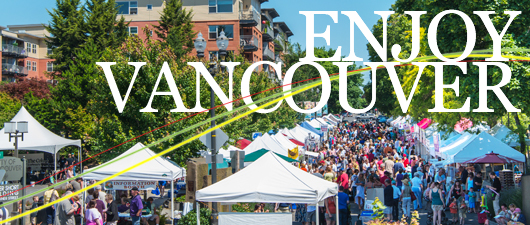Vancouver, Washington, the fourth largest city in Washington, combines the excitement of a major metropolitan area with easy access to recreational opportunities. Vancouver’s vibrant downtown and a public square was named one of the Great Public Spaces in America by the American Planning Association.
Vancouver was named The Most Hipster City in the USA, “based on the number of microbreweries, thrift stores, vegan restaurants and tattoo parlors per 100,000 residents. The Chamber of Commerce has 10 Reasons to Visit Vancouver USA.
Vancouver’s walkable downtown features retail shops, restaurants, art galleries, Esther Short Park, which hosts 30 summertime concerts. The Columbian’s Events Page has the latest.
Vancouver Farmers Market is open every Saturday and Sunday, March 17th through October 28th, and is next to Ester Short Park, in the center of downtown Vancouver. It’s a lively and engaging destination with music and activities for the whole family.
Established in 1853, Ester Short Park, is the oldest public park in the state of Washington. The park hosts many outdoor summer concerts, and was honored as one of the nation’s “ten great public spaces” by the American Planning Association. Interesting architecture includes a brand new library and the newly remodeled Kiggins theatre.
Vancouver’s Community & Economic Development Department says the SW Washington region is home to software companies, printer and tablet manufacturers, audio and optoelectronics firms in the high tech sector.
The Confluence Project is creating interpretative public art, environmental restoration and providing educational programming at the community level.
The Land Bridge is a pedestrian overpass that takes you over the SR-14 freeway to Fort Vancouver, probably Vancouver’s signature attraction.
Fort Vancouver National Historic Site was one of the first permanent settlements west of the Mississippi and was the central hub for trading in the Pacific Northwest. Set on 191-acres next to the Columbia River, it was established in the mid 1820’s.
The current reconstructed fort has restored buildings in their original locations. Those buildings include the Chief Factor’s House, a bastion, seasonal gardens, an outlying village and working trade houses for baking, carpentry, and blacksmithing.
The entrance fee into Fort Vancouver is only $5 for those 16 years and older, and visitors can take advantage of free National Park Service days on specific holidays and during National Park Week.
The Pearson Field Airport is operated by the City of Vancouver while the Pearson Field Education Center is operated by the Fort Vancouver National Trust and the Pearson Air Museum is operated by the National Park Service.
The Pearson Air Museum is free of charge, and features rotating exhibits celebrating the area’s military and aviation history. Both the reconstructed fort and Pearson Air Museum are open to the public Tuesday through Saturday.
The first circumnavigation of the globe by air was achieved in 1924 by a team of aviators from the U.S. Army Air Service. The trip lasted 175 days, covered approximately 27,000 miles, and included landings in 22 different countries. Three Douglas World Cruisers left Santa Monica on March 17, 1924, heading for Seattle, the official start point of the flight. They landed at Pearson Field on March 19, 1924.
The two World Cruisers that completed the journey – the Chicago and the New Orleans – made Vancouver Barracks their last stop before their triumphant return to Seattle.
September 9th is the annual Campfires and Candlelight event, which brings the fort to life at night with only lanterns, candles and campfires. Volunteers in 19th century period costumes lead living history demonstrations and give tours.
On the hill, above Fort Vancouver (which is close to State Route 14) is Officers Row which features 22 preserved Victorian homes on the National Historic Register. The Clark County Historical Museum offers tours.
The restored Victorian homes include the General George C. Marshall House, built in 1886 and his residence from 1936 to 1938 while Marshall commanded the Third Division’s fifth Infantry Brigade and the region’s Civilian Conservation Corps camps.
The General O.O. Howard House is an Italianate-style home built in 1878 and was the last historic structure to be rehabilitated on Officers Row. It was first occupied by General Oliver Otis Howard, founder of Howard University, and the commanding general of the Department of the Columbia from 1874 to 1880. The house is the headquarters for The Fort Vancouver National Trust, which handles day-to-day operations of Officers Row. Stop in the Eatery at the Grant House for a glass of local wine on the veranda.
Augmented Reality company RealWear has their headquarters at the historic Fort Vancouver Barracks. A Fort Vancouver Mobile app is available for Apple and Android.
The Waterfront Renaissance Trail to check out Beaches Restaurant or McMenamins on the Columbia. Both eateries offer outdoor seating with great views of the river.
Vancouver Bike Maps (pdf) and Vancouver Parks and Recreation Trail Maps have information on regional parks.















